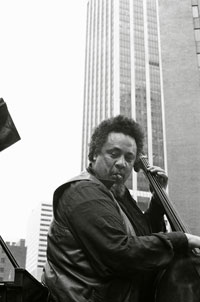
As the1950s drew to a close, the Jazz scene in America was flourishing. A myriad of previously popular styles – from Dixieland and big band to more recent forms like be-bop and west coast cool – were either evolving or making way for the brave new world of hard bop, free jazz and Afro-centric explorations.
A half century on, deluxe editions of three landmark albums from the era – by Charles Mingus, Dave Brubeck and Miles Davis – are being released under the banner ‘1959-Jazz’s Greatest Year,’ by Columbia/Legacy Records.
It’s not just a marketing ploy; the year really was pivotal; the future was upon us, and while Kennedy’s New Frontier was still to come, the music was already well out of the gate.
In addition to the titles in this series, 1959 brought John Coltrane’s seminal Giant Steps, Ornette Coleman’s groundbreaking The Shape of Jazz to Come, and important efforts from Cannonball Adderley, Ray Charles, Duke Ellington and Oscar Peterson.
The Legacy titles were originally issued on Columbia Records – a major label with all the resources that implied: marketing departments, nationwide distribution, radio play and more. Independents like Riverside, Prestige, Blue Note, Atlantic, Pacific Jazz and Savoy all boasted formidable rosters – but that extra clout meant the music had a far great chance of being heard by a mass audience.
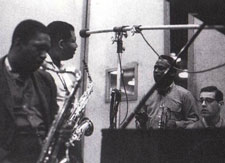
While it’s hard to imagine in today’s world of lightweight pop fodder, the recordings in this series were all popular sellers. Brubeck even scored a hit single; ‘Take Five’ is one of only a handful of odd time signature pieces to ever grace the pop charts. Miles’ Kind of Blue would become the most popular jazz LP ever released.
For the uninitiated, Mingus Ah Um Deluxe Set is a perfect starting point into the legendary bassist/composer’s music. Mingus recorded extensively for a wide range of labels, with only two albums for Columbia during the era (he would return in the 70s); Mingus Ah Um and Mingus Dynasty. Both are included in this package, along with 7 bonus tracks, making for over 2 hours of music.
 The disc opens with ‘Better Git It In Your Soul,’ which is described in the liner notes as “a grand slam home run – an infectious multi-layered gospel piece.” It’s not likely to be heard in conservative churches anytime soon, but it is an excellent example of how the form was incorporated into so much of his work.
The disc opens with ‘Better Git It In Your Soul,’ which is described in the liner notes as “a grand slam home run – an infectious multi-layered gospel piece.” It’s not likely to be heard in conservative churches anytime soon, but it is an excellent example of how the form was incorporated into so much of his work.
Mingus grew up in the Pentecostal Church, raised by a religious step-mother who only allowed gospel music in the home. His parents argued frequently regarding what each felt was the ‘proper’ denomination, which undoubtedly left him confused. (Then again, they argued about nearly everything else as well). He learned to play in the church band and sang in the choir, and that early experience would inform all that came after.
Much of his music brings to mind a revival meeting, especially ‘Wednesday Night Prayer Meeting’ (from Blues and Roots – also recorded in 1959). ‘Ecclusiastics,’ (a play on ‘Ecclesiastics’) deals directly with faith, and tracks like ‘Love Chant’ and ‘Prayer for Passive Resistance’ are clearly gospel-derived.
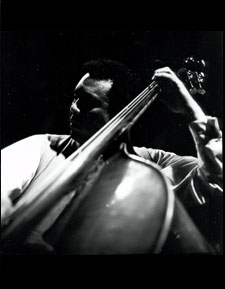 Black Saint and the Sinner Lady, a six-part opus from 1963 reflects the confusion he felt regarding faith and worldly matters. Mingus had his psychologist pen the liner notes, which read in part; “One feels deeply for the tears of Mr. Mingus that fall for himself and man. There can be no question that he is the Black Saint who suffers for his sins and those of mankind as he reflects his deeply religious philosophy. His music tells of his deep yearning for love, peace and freedom.” Mingus’ longstanding fascination with psychology – coupled with a distinctive sense of humor – resulted in titles like ‘All The Things You Could Be By Now If Sigmund Freud’s Wife Was Your Mother.’
Black Saint and the Sinner Lady, a six-part opus from 1963 reflects the confusion he felt regarding faith and worldly matters. Mingus had his psychologist pen the liner notes, which read in part; “One feels deeply for the tears of Mr. Mingus that fall for himself and man. There can be no question that he is the Black Saint who suffers for his sins and those of mankind as he reflects his deeply religious philosophy. His music tells of his deep yearning for love, peace and freedom.” Mingus’ longstanding fascination with psychology – coupled with a distinctive sense of humor – resulted in titles like ‘All The Things You Could Be By Now If Sigmund Freud’s Wife Was Your Mother.’
There are three tributes to his musical influences: ‘Goodbye Pork Pie Hat’ (aka ‘Theme For Lester Young’) is dedicated to the tenor sax legend; ‘Open Letter to Duke’ is for Ellington (Mingus Dynasty includes a take on the Duke’s ‘Things Ain’t What They Used To Be’), and ‘Jelly Roll’ is for pianist Jelly Roll Morton.
‘Bird Calls’ might sound like a tribute to sax legend Charlie ‘Yardbird’ Parker, but that would come on Dynasty as well, with ‘Gunslinging Bird.’ The full title – ‘If Charlie Parker Were A Gunslinger, There’d Be A Whole Lot of Dead Copycats’ shows equal parts humor and respect for the sax giant.
Mingus addressed race relations repeatedly on tracks like ‘Meditations on Integration,’ and ‘Freedom.’ His background offered a unique perspective: his Mother was a mix of Chinese and English, and his father was the illegitimate offspring of a Black farmhand and his Swedish employer’s white granddaughter.
Ah Um includes ‘Fables of Faubus,’ easily one of his most powerful statements. It was a response to the segregated south, specifically an Arkansas governor who deployed the National Guard in an effort to prevent a handful of black children from attending a court-ordered integration of a state high school.
Columbia refused to allow the lyrics to be sung on the recording, but live performances from the era allow us to witness his righteous anger: “Oh Lord, don’t let ‘em shoot us!/Oh Lord, don’t let ‘et stab us!/Oh Lord, don’t let ‘em tar and feather us!/Oh Lord, no more swastikas!/Oh Lord, no more Ku Klux Klan!’
 The distinctive cover design of Mingus Ah Um – depicting a revival meeting -was the work of Columbia art director Neil Fujita. Fujita was also responsible for the Dave Brubeck Quartet’s Time Out, capturing on canvas a bold, modern look that reflected perfectly the group’s sophisticated sound.
The distinctive cover design of Mingus Ah Um – depicting a revival meeting -was the work of Columbia art director Neil Fujita. Fujita was also responsible for the Dave Brubeck Quartet’s Time Out, capturing on canvas a bold, modern look that reflected perfectly the group’s sophisticated sound.
By 1959, Brubeck had been recording for a decade, with a string of popular albums under his belt, but Time Out was different. In a 2003 interview (included on DVD), he explained; “I wanted to do an experimental album using time signatures that weren’t usual in jazz.”
It hardly sounds like a formula for increased sales, yet that’s exactly what happened. Time Out meshed intellectual pursuits with a groove that even non-musicians could appreciate. ‘Take Five’ became the first-ever million selling jazz single, and the LP remained in the Billboard Pop Album charts for over 3 years, peaking at the #2 position.
The expanded set is bolstered by an additional disc collecting various Newport Jazz Festival appearances, plus a DVD interview and interactive piano lesson from Brubeck offering 4 different angles to watch his hands as he plays ‘Three To Get Ready.’
 Nineteen fifty-nine was a banner year for Miles Davis. He had changed the rules of hard bop the previous year with Milestones, and Kind of Blue (released in the summer of 1959) expanded his audience tenfold. Before the year was out, he was recording Sketches Of Spain, another high water mark.
Nineteen fifty-nine was a banner year for Miles Davis. He had changed the rules of hard bop the previous year with Milestones, and Kind of Blue (released in the summer of 1959) expanded his audience tenfold. Before the year was out, he was recording Sketches Of Spain, another high water mark.
Blue is not included in the 1959 series, but that’s not a slight: the album received a deluxe reissue earlier this year. Arguably the most important, and certainly the most popular jazz album ever released, Blue captured a landmark moment in the evolution of jazz, as swing gave way to subtle, understated cool.
The band – Miles on trumpet, pianist Bill Evans, sax players John Coltrane and Cannonball Adderley, bassist Paul Chambers and drummer Jimmy Cobb – was second to none, and short lived. Their understated performance on modal classics like ‘Freddie Freeloader,’ ‘All Blues,’ (which consists of only 2 chords) and ‘So What,’ would influence generations of players to come by use of modes rather than chord changes.
Despite it’s stellar reputation, for the first forty years, Blue was not exactly as intended. Three tracks – more than half the album – were mastered at the wrong speed, and LP jackets reversed two song titles. The errors were finally corrected 10 years ago.
The album has seen a number of incarnations, including the original vinyl, tape, Compact Disc, audiophile LP, remastered and expanded disc, SACD, and even in the short-lived Dualdisc format.
 Legacy’s double disc set contains all the essential material, but for those who want everything Miles-related, the deluxe edition offers even more. What makes this version special? For a start, the packaging; the original album appears twice, on CD and as a 180-gram record – fittingly pressed on blue vinyl. A second CD contains outtakes plus a short live performance, and a DVD features an hour long documentary on the making of the album, along with a 1959 TV appearance of the band performing live.
Legacy’s double disc set contains all the essential material, but for those who want everything Miles-related, the deluxe edition offers even more. What makes this version special? For a start, the packaging; the original album appears twice, on CD and as a 180-gram record – fittingly pressed on blue vinyl. A second CD contains outtakes plus a short live performance, and a DVD features an hour long documentary on the making of the album, along with a 1959 TV appearance of the band performing live.
Add a coffee table size hardcover book, poster, photos and other memorabilia, all encased in a 12-inch by 12-inch slipcase, and you’ve got a major contender for reissue of the year.
 Sketches of Spain was the last of three major collaborations on Columbia between Davis and Canadian arranger Gil Evans. The two first worked together in 1949 (collected on Capitol Records’ 1957’s release Birth of the Cool). After Davis signed with Columbia, they collaborated on Miles Ahead (1957) and Porgy And Bess (1958) before Sketches. It was a significant relationship; famous for always moving forward, the only time Davis looked back was on his final release, revisiting Evan’s arrangements on a live album recorded at the Montreaux Jazz Festival.
Sketches of Spain was the last of three major collaborations on Columbia between Davis and Canadian arranger Gil Evans. The two first worked together in 1949 (collected on Capitol Records’ 1957’s release Birth of the Cool). After Davis signed with Columbia, they collaborated on Miles Ahead (1957) and Porgy And Bess (1958) before Sketches. It was a significant relationship; famous for always moving forward, the only time Davis looked back was on his final release, revisiting Evan’s arrangements on a live album recorded at the Montreaux Jazz Festival.
In theory, Sketches’ Spanish motif may have appeared at odds with jazz tradition, yet the melancholy flamenco music was not far removed from the blues forms Davis had started with.
Taking up almost the entirety of side one, the centerpiece of the album is an excerpt from Spanish composer Rodrigo’s 1939 guitar work, Conciertio de Aranjuez. Rodrigo was taken aback when he learned there was a jazz treatment of his piece, and threatened to sue. Subsequent royalty payments convinced him otherwise.
The album was not without precedent. Kind of Blue had offered a foretaste with ‘Flamenco Sketches,’ and Miles Ahead contained ‘Blues For Pablo’ and 19th Century French composer Leo Delibes’ ‘The Maids of Cadiz’ (included here as a bonus track).
Like Brubeck’s Time Out, the playing on Blue and Sketches is lyrical and relaxed, and works on a number of levels. Each album stands up to intense scrutiny, yet, conversely, is suitable for background music.
That’s hardly to case with two concurrent Legacy reissues from the same era. Tito Puente and Babatunde Olatunji would never be mistaken for background music, and they aren’t strictly jazz, but each is well worth checking out for fans open to adventurous sounds.
There were popular Latin entertainers before Puente, but few possessed his astute musical sensibility and flamboyant showmanship.
Known as the King of Mambo, King of the Timbales, or simply ‘El Ray,’ Puente was born in New York City of Puerto Rican descent, not Cuban as commonly assumed. After serving in the US Navy, he performed with various small groups before debuting as a band leader in 1949 – sharing the bill with fellow up-and-comer Tony Bennett – to almost overnight success.
Puente’s formula – adding big band horns to the traditional Cuban charanga – created a powerful sound that sparked a nationwide Latin dance craze. The music crossed cultural and economic lines; audiences packing his house gig at New York’s Palladium Ballroom transcended every social strata.
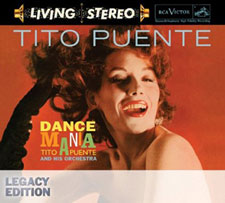 Of the over 120 albums he recorded, Dance Mania – which was released in 1958 on RCA – was by far the most popular. In 2000, the New York Times listed it as one of the 25 “most significant albums of the last century.”
Of the over 120 albums he recorded, Dance Mania – which was released in 1958 on RCA – was by far the most popular. In 2000, the New York Times listed it as one of the 25 “most significant albums of the last century.”
There’s a sense of joy throughout, with percussion-driven mambos, rumbas, cha-chas and more. Unlike Brubeck, Miles and Mingus, Puente’s music was created first and foremost for dancing. Not that his credentials were in question – Latin music was a perfect vehicle for jazz players looking to access larger audiences without compromising their talent. Players like Dizzy Gillespie, Cal Tjader and Stan Getz worked extensively within the genre.
Packaged with the 1962 sequel Dance Mania Vol. 2, plus 21 bonus tracks, this expanded edition is a perfect introduction to Puente’s magic.
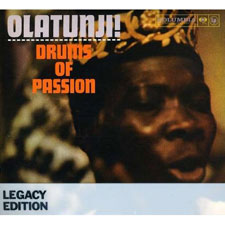 As the first-ever West African chant and drumming recording made in the U.S., Babatunde Olatunji’s 1959 debut Drums of Passion was a brand new sound for western ears. As a Nigerian medical student living in New York City, Olatunji was well aware of the cultural divide, and tailored his music for American audiences. The album title might bring to mind Martin Denny’s popular Exotic Percussion LPs of the 1950s, but this was as far from cocktail music as one could imagine. Rooted in African tradition, the sound was dense and demanding, yet found immediate acceptance with record buyers.
As the first-ever West African chant and drumming recording made in the U.S., Babatunde Olatunji’s 1959 debut Drums of Passion was a brand new sound for western ears. As a Nigerian medical student living in New York City, Olatunji was well aware of the cultural divide, and tailored his music for American audiences. The album title might bring to mind Martin Denny’s popular Exotic Percussion LPs of the 1950s, but this was as far from cocktail music as one could imagine. Rooted in African tradition, the sound was dense and demanding, yet found immediate acceptance with record buyers.
Olatunji became a musical ambassador of sorts, performing before the United Nations General Assembly (Soviet Union Premier Nikita Khrushchev took his shoes off and danced) as well as the 1961 inauguration of President John Kennedy.
The percussionist released six albums on Columbia Records. The first and last (1966’s More Drums of Passion) are included in the Legacy edition, along with nine jazz-oriented bonus tracks.
After 40 minutes of drums and chanting, it’s a bit of a shock to hear a 1961 recording with a bass line similar to John Coltrane’s ‘A Love Supreme,’ which was still a few years off. In fact, Coltrane was a fan; in 1962 he composed ‘Tunji,’ in honor of the percussionist, and later helped found the Olatunji Center for African Culture in Harlem, where the sax giant would record his final concert in 1967.
While neither faded away, Puente and Olatunji enjoyed their greatest popularity as the fifties made way for the sixties. A decade later, Carlos Santana created one the biggest acts of the seventies by adding a rock rhythm section to what had come before; Santana’s first three albums contained remakes of Olatunji (‘Jin-Go-Lo-Ba’) and Puente (‘Oye Como Va,’ and ‘Para Los Rumberos’) bringing their pioneering efforts to a whole new generation.
© John Cody 2009
